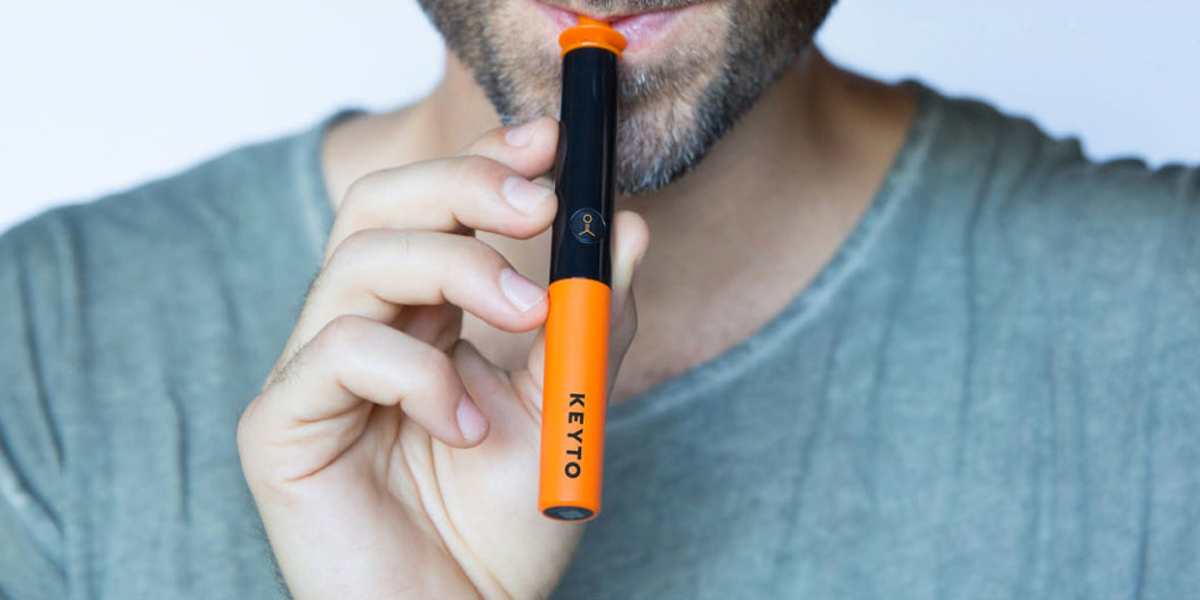A very important part of success with the keto diet is keeping track of your progress. While you should make an effort to monitor your diet and macros, monitoring your ketones is also crucial. Why? Because knowing your keto level allows you to understand if you’re burning fat as fuel and can also help you uncover hidden sugar and carbs in the food you eat.
Table of Contents
How to measure ketosis
One of the wonderful things about following the keto diet is that there are several biomarkers you can use to track and monitor your progress. These ketone bodies are produced as a byproduct of being in nutritional ketosis. The three most common ways of measuring ketones are:
- urine – acetoacetate
- blood – β-hydroxybutyrate
- breath – acetone testing
Below we’ll cover the basics and the pros and cons of each method.
How to test for ketones in urine
- Obtain urine ketone strips at your local pharmacy or online
- Ensure the package is unopened and not expired
- Pee in to a cup and on the strip
- Allow the strip to change color
- Compare the color to the legend provided on the bottle to determine your level of ketosis
The level of ketones in the body can be measured via a urine test using ketone test strips that are commonly used and easily found in any pharmacy. Ketones are released in the form of acetoacetate through your urine. They normally come in packages of 50, 100 or 200 units and cost an average of $10 per 200 units.
While the procedure is quite simple, it can be uncomfortable (particularly for ladies). To perform a test, you should dip the strip pad-side down into a fresh urine sample or simply urinate directly on the strip. After 30 seconds – one minute, the tip of the ketones test strip should change its color indicating your current ketones level. The containers usually come with a color chart you can use to compare and read the keto strips. If the strip does not change color, this usually indicates that you do not have a detectable amount of acetoacetate in your urine (not in ketosis) or the strips could be contaminated or expired.
To keep your results as accurate as possible, be sure to do the following:
- Test different methods of testing – some users report different results when urinating directly on the strip vs. peeing into a cup
- Test different times, ketone presences varies depending on the time of day
- Replace the cap after taking out strips
- Don’t expose the strips to strong light or moisture
- Don’t remove the desiccants
- Don’t get the testing area dirty and try to avoid touching it with your fingers
- Check your expiration dates!
Please keep in mind that ketone test strips are not 100% accurate. They are a great option for beginners, but as your body adjusts to being in ketosis, the levels of acetoacetate acid in your urine might drop, resulting in the strips not showing an accurate reflection of your level of ketosis.
We have an entire guide on how to read ketone strips which you should check out if you want to give ketone strips a try.
Pros: low initial cost, ketone strips are easy to find in stores and pharmacies
Cons: messy, and at times unclear results. Over time this becomes an increasingly unreliable method when you’re keto-adapted. Not very practical without a bathroom nearby.
How to do a keto blood test or blood β-hydroxybutyrate test
- Get your materials: purchase a keto blood test and compatible testing strips, as well as a lancet (the tool used to poke yourself and draw blood) if it doesn’t come with one.
- Pre-load your strip first in to the device to avoid losing or smearing your bead of blood
- Clean your finger tip or the area you intend to poke
- Collect the bead of blood. Ideally place it at a 45* degree angle at the bottom corner of the bead for optimal absorption
- Wait for your results!
The keto blood test reads the levels of β-hydroxybutyrate in your blood and returns your blood ketone concentration via the screen, giving you accurate results. Ketone blood tests are easy to do yourself using small blood meters similar to the glucose meters used by people with diabetes, called blood ketone meters. In fact most glucose meters offer strips that also measure ketones, too. The levels of Beta Hydroxybutyrate in your blood are usually shown in mmol/L (millimoles per liter) and they usually go from 0 to 3.
The average range is less than 0.5 mmol/L. Therefore, if you are below 0.5 mmol/L, you are not in or are barely in ketosis. The ideal level is 1-1.5 mmol/L; this means you are in ketosis. Levels above 1.5 mean your body is producing too much BHB and is not utilizing your ketones correctly. Levels above 3 can be dangerous and mean that you’re either consuming way too much fat or are in a deep starvation mode.
The four most popular blood ketone meters are CareTouch, Keto-Mojo, Nova Max Plus and Precision Xtra. They all come with a few ketones test strips, a carrying case and a manual. The blood ketone monitors usually cost about $60-$100, but the strips cost about $1 each, making it significantly more expensive over time. Having used both Keto Mojo and Precision Xtra, we like both options and don’t think one is better than the other. The most important rule to follow is to use your results directionally, and because each device is different be sure to keep using your specific device for best results.
Pros: accurate measurement and clear results provided via the screen
Cons: painful finger pricks, high cost due to the disposables (strips that cost ~$1 each). If you have a bad blood draw, you might have to poke yourself multiple times. Some variability depending on your level of hydration is to be expected as well. Not very practical when you’re out and about/traveling as you need to carry the device, strips and a lancet.
How to measure ketosis with breath acetone – Keyto
- Purchase a Keyto here and download the Keyto app on iOS or Android
- Insert the battery, open the app and pair the device
- Hit the (+) on the app’s home screen, wait for the Keyto to warm up
- Blow in to the device when prompted. Avoid taking a big breath in before – your highest ketone concentration is at the end of your breath
- Get your results! For best results, track your weight loss as well over time with your Keyto app
Keyto is our proprietary Ketone Breath sensor that’s as portable as a vape pen and measures acetone released through your breath to determine your level of ketosis. Acetone in your breath is produced as a byproduct of using ketones for energy, giving you an additional biomarker to track your progress that’s non-invasive. The breath analyzer will show you your Keyto level, which gives you rapid feedback on how you’re doing and how much fat you are burning. The device is connected to our Keyto app that gives you advice on what to do and what to eat based on your Keyto level. All you have to do is to blow into Keyto to get your results – no painful and expensive blood tests or messy urine strips! Aim for a Keyto level of at least 4-5 for optimum ketosis.
How Keyto works
Keyto uses a precision nanosensor that can detect acetone in human breath at a concentration of 1-2 parts per million (PPM), making the results quite accurate. Because each device is fundamentally unique, each device is lovingly calibrated by our team during the manufacturing process. Also, there’s no need to buy any additional accessories and the app is free. So, while the acetoacetate and the Blood β-hydroxybutyrate tests’ strips are non-reusable, Keyto gives you many reads from one single purchase. To learn more about how the Keyto works, read this article by our founder.
The Keyto offers:
- Instant & accurate breath acetone readings
- Easily accessible actionable insights in your app dashboard
- Personalized meal plans
- Delicious and easy keto-friendly recipes
You can learn more about Keyto and order yours here!
Blood vs. breath vs. urine for measuring ketosis
- While ketone test strips are very easy to use, they can be unsanitary since they require direct contact with your urine. Additionally the results are not very accurate for people whose bodies have already adapted to ketosis. Lastly the test strips are, of course, non-reusable, which forces you to buy more and more until it becomes a recurring cost.
- The blood β-hydroxybutyrate test can give you very accurate results. However, it requires you to prick your finger every time you want to get tested, which for some is several times a day, which becomes tiring overtime. The ketones blood monitors are not very expensive, but like urine strips, the blood strips it uses are non-reusable and generally cost $1/ strip, which could be a daily cost of $1-4/day depending on how often you test yourself.
- According to the NIH, breath acetone is a reliable indicator of ketosis. We think analyzing the acetone level using a Ketone Breath meter like Keyto is the most convenient, sanitary and affordable option longterm. First of all, it’s a one-time purchase. Once you buy Keyto, that is all you will need (minus the occasional battery). Also, since your Keyto is connected to an app, you get not only your Keyto levels but the ability to store historical ketosis levels and advice on how to improve or keep up the good work.
No painful finger pricking or unsanitary pee strips necessary. Keyto removes the invasive, inaccurate, expensive and painful barrier for tracking your ketosis.





